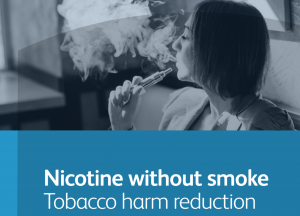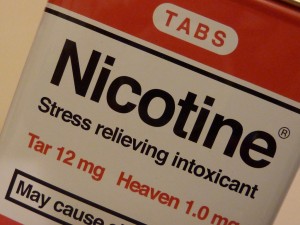
Yesterday the Royal College of Physicians (RCP) published the latest in a series of major reports on tobacco and nicotine, a series that first began in 1962. This report assesses the public health controversies surrounding low risk non-combustible nicotine products (“nicotine without smoke”), such as e-cigarettes.
Controversies centre around:
- How harmful e-cigarettes and other non-combustible products are, when compared to smoking tobacco
- Whether these products somehow encourage smoking through gateway effects, ‘renormalising’ smoking or reducing the rate at which smokers quit
- The role of the tobacco industry
Much research in this field generates alarmist publicity, but does not stand up to reality checking or more searching scrutiny. The new RCP report provides an exhaustive and much-needed examination of these issues, which builds on the evidence update commissioned by Public Health England last year (McNeill et al, 2015).
At 206 pages long, you would be excused for wondering if there is enough time in the day to read all of the new RCP report. However, at the end of each section a summary has been provided with all the important points, and even better, yours truly has written a clear and succinct blog about it!

The new RCP report features contributions from an expert working group.
Methods
The RCP document contains a literature review, evidence synthesis and policy appraisal. The working party report does not give an assessment of the quality of papers reviewed, so this is not a systematic review or an evidence-based guideline.
However, the report does give the overall expert judgement of the RCP Tobacco Advisory Group on the main controversies, which given the quality of evidence currently available in this field, is very much worth paying attention to.

People smoke because they are addicted to nicotine, but are harmed by other constituents of tobacco smoke.
Results
For consumers, the most important findings are:
- People smoke because they are addicted to nicotine, but are harmed by other constituents of tobacco smoke.
- The main risks of smoking arise from tobacco smoke rather than nicotine.
- The hazard to health arising from long-term vapour inhalation from the e-cigarettes available today is unlikely to exceed 5% of the harm from smoking tobacco. (This validates and reinforces Public Health England’s 2015 statement that “e-cigarettes are around 95% less harmful than smoking”)
- There are concerns that e-cigarettes will increase tobacco smoking by renormalising the act of smoking, acting as a gateway to smoking in young people, and being used for temporary, not permanent, abstinence from smoking. To date, there is no evidence that any of these processes is occurring to any significant degree in the UK.
- Rather, the available evidence to date indicates that e-cigarettes are being used almost exclusively as safer alternatives to smoked tobacco, by confirmed smokers who are trying to reduce harm to themselves or others from smoking, or to quit smoking completely.
- There is a need for regulation to reduce direct and indirect adverse effects of e-cigarette use, but this regulation should not be allowed to significantly inhibit the development and use of harm-reduction products by smokers.
- In the interests of public health it is important to promote the use of e-cigarettes, NRT (nicotine replacement therapy) and other non-tobacco nicotine products as widely as possible as a substitute for smoking in the UK.
The report makes it clear that, so far, the population effects of e-cigarette use have been positive with no evidence of a ‘gateway’ to smoking traditional cigarettes in adolescents or adults. Experimentation is mainly just that in teenagers, with very few moving into continued use. Uptake by smokers is largely happening outside of NHS smoking cessation services who have seen a drop in numbers in recent years. Although this is not wholly attributable to vaping, it suggests that these services should become more open to embracing the concept of harm reduction and e-cigarette use.
Given this positive view, the report casts more doubt on the wisdom of the regulation that will come in on 20 May 2016, imposing great costs and burdens on the makers of these products. The RCP recommends some regulation, but is clear that this should improve what is available to consumers and encourage switching, not damage and distort the market and have numerous unintended consequences that protect the tobacco industry and keep people smoking who might otherwise switch to vaping.

The report concludes that hazards to health arising from current e-cigarettes are unlikely to exceed 5% of the harm from smoking tobacco.
Conclusions
The report emphasises the potential for policy in this area to do more harm than good. There is a great focus on the history of smoking in teenagers and the tobacco control measures that have been employed to discourage use in this age bracket. It is recognised that applying the same rules to vaping products could have a detrimental effect and draws on data from Harvard that finds the US states with strict minimum purchase ages have seen lower declines in smoking prevalence.
It also expresses concerns at the EU legislation, the Tobacco Products Directive (TPD), and some of the requirements that demand warnings to be placed on e-cigarette packaging that may deter smokers from switching, with messages about the addictiveness of nicotine and poisoning risk being misplaced and not evidence based. The takeaway from this section is there is great concern that the TPD does not include a mechanism to review the legislation if it is found to be detrimental to public health. It recommends that the 2.5 year earliest review point is too long and that the UK government should review one year after implementation.

The report argues that regulations should enable and encourage smokers to use alternative non-tobacco products.
Strengths and limitations
A particular strength of the report is to move away from a purely medical model of vaping, in which e-cigarettes function as a kind of ‘super-NRT’ . It draws heavily on the success of snus in Scandinavian countries. Snus is a consumer product, used for pleasure and opposed by many public health authorities. Yet it is the reason why Sweden’s smoking and disease rates are so low. The report notes that the social acceptability and easy availability of snus is proof of concept: that where there is access to risk reduced products for smokers, they will adopt them with little encouragement and pressure from authority. This model has allowed Sweden to boast the lowest smoking rates in Europe (11% compared to the EU average of 26%) by some margin, using a product that has been illegal in the UK since 1992.
The expert consensus methodology adopted by this working party report is a clear limitation. This document has been produced with input from a wide range of expert researchers, policy makers and senior charity executives, but the report does not give an independent assessment of the quality of papers reviewed, as you would find in a systematic review or evidence-based guideline.
Summary
Nonetheless, this is a very strong document that puts the risks of smoking compared to vaping in perspective for the individual, and shows that the population effects are positive rather than negative. It makes it clear that the benefits of e-cigarettes and other “nicotine without smoke” products must be communicated to the public in order to maximise the potential of these harm reduction options. Policy should encourage not obstruct products that allow recreational nicotine to be consumed in a safe and appealing way.
Tobacco use has evolved over the centuries but these developments should be seen as a great turning point that allows those inclined to use nicotine to indulge in a habit they enjoy at a fraction of the harm. It is time health professionals moved on to come to peace with a product that is helping millions of current and potential ex-smokers across the world. The message is very strong, from what we know right now there is very little to fear and much to be hopeful for.

The report recommends promoting the use of e-cigarettes, NRT and other non-tobacco nicotine products as widely as possible as a substitute for smoking in the UK.
Links
Primary paper
Royal College of Physicians (2016) Nicotine without smoke: Tobacco harm reduction. A report by the Tobacco Advisory Group of the Royal College of Physicians. April 2016.
Other references
McNeill A, Brose LS, Calder R, Hitchman SC, Hajek P, McRobbie H. (2015) E-cigarettes: an evidence update. A report commissioned by Public Health England (PDF). Public Health England, Aug 2015.
New Nicotine Alliance web site: http://nnalliance.org/

Incredibly grateful to be able to do this for @Mental_Elf. A summary of the @RCPLondon Nicotine Without Smoke report https://t.co/NZahzgU3OB
@CaeruleanSea @Mental_Elf @RCPLondon I hope they’re already aware that some people on clozapine who vape have reduced doses of clozapine
@andy38leach @Mental_Elf @RCPLondon Yes, heared this from @grannylouisa too
@CaeruleanSea @Mental_Elf @RCPLondon @grannylouisa I’ve been successful at converting almost aan entire care company to vaping clients to:-)
@andy38leach what company is that? @CaeruleanSea @Mental_Elf @grannylouisa
@RhydoBaggins @CaeruleanSea @Mental_Elf @grannylouisa I would not be able to say I’m afraid Rhydders. Confidentially :-)
@CaeruleanSea @andy38leach @Mental_Elf @RCPLondon @grannylouisa isn’t that because something in smoke makes drug metabolise more quickly?
@Twigolet @CaeruleanSea @Mental_Elf @RCPLondon @grannylouisa I can’t give a qualified answer to that but seems reasonable
@andy38leach @CaeruleanSea @Mental_Elf @RCPLondon @grannylouisa IIRC smoking cessation by any means causes increased levels of drug in blood
@Twigolet @andy38leach @Mental_Elf @RCPLondon @grannylouisa Seems so. That has to be a good thing, surely. Allowing ppl to reduce meds?
@CaeruleanSea @andy38leach @Mental_Elf @RCPLondon @grannylouisa financially good yes.
@CaeruleanSea @Twigolet @Mental_Elf @RCPLondon @grannylouisa Good for their health and Good for NHS wealth. Vaping is Win Win for all :-)
@CaeruleanSea @Twigolet @andy38leach @Mental_Elf @RCPLondon that’s right
@Twigolet @CaeruleanSea @andy38leach @Mental_Elf @RCPLondon yes, no smoke, smaller doses of meds needed #WinWin
NOT about the nicotine
.@CaeruleanSea @Mental_Elf @RCPLondon L O V E. Well done, Mrs. Sea.
.@CaeruleanSea’s summary of the @RCPLondon Nicotine Without Smoke report about #ecigs on @Mental_Elf https://t.co/Ut2KEOiQNQ
Today @CaeruleanSea considers new @RCPLondon report on #ecigs #vaping https://t.co/vf76fOXoTv @NoSmokingDay
Nicotine without smoke: new RCP report on e-cigarettes and tobacco harm… https://t.co/X5vgJgzVBN #MentalHealth https://t.co/kAoAydPJzh
.@RCPLondon recommends #ecigs, NRT & other non-tobacco nicotine products as substitute for UK tobacco smoking https://t.co/vf76fOXoTv
Smoking is the biggest avoidable cause of death & disability, & social inequality in health, in the UK https://t.co/vf76fOFO1X
RT @CaeruleanSea: Have you seen the report from @RCPLondon @StopSmokingCIOS? https://t.co/NZahzhbFdb consumable overview here
RT @Mental_Elf: Smoking is the biggest avoidable cause of death & disability,& social inequality in health in the UK https://t.co/Wocp8XLhb6
Strong endorsement of #vaping #ecigs for #smoking harm reduction in new @RCPLondon report https://t.co/vf76fOFO1X https://t.co/na7jNsKh9P
@Mental_Elf @RCPLondon It would be great if we could achieve addnl 0.4% (180k)annual decline as with snus.We are only at 19k pa at present
@Mental_Elf @RCPLondon and as the report implies,the new TPD is likely to hinder rather than help bridge this gap.Detailed proposals needed!
@Mental_Elf @RCPLondon If West’s nos. are right,it will need ~3m additional ecig QAs pa to generate 150k lifetime quits…
@Mental_Elf @RCPLondon -and with the shutters coming down in <3 weeks on commercial advertising,one hopes @PHE_uk have a cunning plan
@BV_dodderer @Mental_Elf @RCPLondon no, RWs long term quit rate (12mth) for ecigs is 7.5%. Still underestimated IMO.
Listen up smokers!
@RCPLondon report recommends
Switching to #vaping
<5% as harmful
https://t.co/vf76fOFO1X https://t.co/CqCOewICbi
#Ecigs aren’t currently made to meds standards & are probably more hazardous than nicotine replacement therapy #NRT https://t.co/vf76fOFO1X
@Mental_Elf but considerably less harmful than smoking!
Nicotine without smoke: new RCP report on e-cigarettes and tobacco harm reduction https://t.co/oynqNvd1LX
#Ecigs appear to be effective when used by smokers as an aid to quitting smoking, says @RCPLondon https://t.co/vf76fOFO1X
The hazards to health arising from current #ecigs are unlikely to exceed 5% of the harm from smoking tobacco https://t.co/vf76fOFO1X
@DoctorChristian @RCPLondon I actually did a nice easily consumable thing for @Mental_Elf on it https://t.co/NZahzhbFdb
Great summary of the recent reports on ecigs & nicotine: https://t.co/HG4KbHqYZM #vapelife
Don’t miss: Nicotine without smoke: new @RCPLondon report on e-cigarettes & tobacco harm reduction https://t.co/vf76fOFO1X #EBP
RT @vinylarm: Nicotine without smoke: e-cigarettes & tobacco harm reduction https://t.co/4YjNERq1Nm #Smoking #Cessation #MentalHealth #Heal…
ICYMI: Nicotine without smoke: new RCP report on e-cigarettes & tobacco harm reduction https://t.co/BA7i1poOVh – the brilliant @CaeruleanSea
@FergusMason1 @tedterry1 A handy summary of which can be found here ;) https://t.co/NZahzhbFdb
@VapinGreek @tedterry1 Mayor shd read full @RCPLondon report, but summary here https://t.co/fJqv1PwTid alternatively https://t.co/Ui1XAyEFL0
RT @abbasian: #Nicotine without smoke: new RCP report on #e-cigarettes and tobacco harm reduction https://t.co/VbWGaNaj6A @Psychiatry_UK
@jppharm @DrG_NHS @AkilaAPh @dolly_sud @paul42smg @hscic eCigs probably safer? There’s no doubt about that https://t.co/DrNueKQeNI